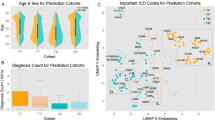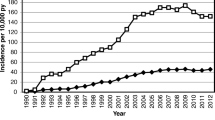Abstract
Summary
Guidelines concerning the definition of failure of therapies used to reduce the risk of fracture are provided.
Introduction
This study aims to provide guidelines concerning the definition of failure of therapies used to reduce the risk of fracture.
Methods
A working group of the Committee of Scientific Advisors of the International Osteoporosis Foundation was convened to define outcome variables that may assist clinicians in decision making.
Results
In the face of limited evidence, failure of treatment may be inferred when two or more incident fractures have occurred during treatment, when serial measurements of bone remodelling markers are not suppressed by anti-resorptive therapy and where bone mineral density continues to decrease.
Conclusion
The provision of pragmatic criteria to define failure to respond to treatment provides an unmet clinical need and may stimulate research into an important issue.
Similar content being viewed by others
References
Food and Drug Administration (1994) Guidelines for preclinical and clinical evaluation of agents used in the prevention or treatment of postmenopausal osteoporosis. Division of Metabolism and Endocrine Drug Products, Food and Drug Administration, Rockville, MD, 1994
Committee for Medicinal Products for Human Use (CHMP) (2006) Guideline on the evaluation of medicinal products in the treatment of primary osteoporosis. Ref CPMP/EWP/552/95Rev.2. CHMP, London, Nov 2006
Body JJ, Bergmann P, Boonen S et al (2010) Evidence-based guidelines for the pharmacological treatment of postmenopausal osteoporosis: a consensus document by the Belgian Bone Club. Osteoporos Int 2:1657–1680
MacLean C, Newberry S, Maglione M et al (2008) Systematic review: comparative effectiveness of treatments to prevent fractures in men and women with low bone density or osteoporosis. Ann Intern Med 148:197–213
National Institute for Health and Clinical Excellence (2010) Final appraisal determination. Alendronate, etidronate, risedronate, raloxifene and strontium ranelate for the primary prevention of osteoporotic fragility fractures in postmenopausal women. NICE, London
National Institute for Health and Clinical Excellence (2010) Final appraisal determination. Alendronate, tidronate, risedronate, raloxifene, strontium ranelate and teriparatide for the secondary prevention of osteoporotic fragility fractures in postmenopausal women. NICE, London
Chapurlat RD, Palermo L, Ramsay P, Cummings SR (2005) Risk of fracture among women who lose bone density during treatment with alendronate. The Fracture Intervention Trial. Osteoporos Int 16:842–848
Watts NB, Geusens P, Barton IP, Felsenberg D (2005) Relationship between changes in BMD and nonvertebral fracture incidence associated with risedronate: reduction in risk of nonvertebral fracture is not related to change in BMD. J Bone Miner Res 20:2097–2104
Ettinger B, Black DM, Mitlak BH (1999) Reduction of vertebral fracture risk in postmenopausal women with osteoporosis treated with raloxifene: results from a 3-year randomised clinical trial. Multiple Outcomes of Raloxifene Evaluation (MORE) Investigators. JAMA 282:637–645
Levis S, Quandt SA, Thompson D et al (2002) Alendronate reduces the risk of multiple symptomatic fractures: results from the fracture intervention trial. J Am Geriatr Soc 50:409–415
Watts NB, Josse RG, Hamdy RC et al (2003) Risedronate prevents new vertebral fractures in postmenopausal women at high risk. J Clin Endocrinol Metab 88:542–549
Barrett-Connor E, Nielson CM, Orwoll E, Bauer DC, Cauley JA (2010) Epidemiology of rib fractures in older men: osteoporotic Fractures in Men (MrOS) prospective cohort study. BMJ 340:c1069
vanStaa TP, Leufkens HG, Cooper C (2002) Does a fracture at one site predict later fractures at other sites? A British cohort study. Osteoporos Int 13:624–629
Johnell O, Oden A, Caulin F, Kanis JA (2001) Acute and long term increase in fracture risk after hospitalization for vertebral fracture. Osteoporos Int 12:207–214
Johnell O, Kanis JA, Oden A, Sernbo I, Redlund-Johnell I, Pettersen C, De Laet C, Jonsson B (2004) Fracture risk following an osteoporotic fracture. Osteoporos Int 15:175–179
Kanis JA (1984) Treatment of osteoporotic fracture. Lancet 1:27–33
Seeley DG, Browner WS, Nevitt MC, Genant HK, Scott JC, Cummings SR (1991) Which fractures are associated with low appendicular bone mass in elderly women? The Study of Osteoporotic Fractures Research Group. Ann Intern Med 115:837–842
Kanis JA, Oden A, Johnell O, Jonsson B, de Laet C, Dawson A (2001) The burden of osteoporotic fractures: a method for setting intervention thresholds. Osteoporos Int 12:417–427
Mackey DC, Black DM, Bauer DC et al (2011) Effects of antiresorptive treatment on nonvertebral fracture outcomes. J Bone Miner Res 26:2411–2418
Marshall D, Johnell O, Wedel H (1996) Meta-analysis of how well measures of bone mineral density predict occurrence of osteoporotic fractures. Br Med J 312:1254–1259
Johnell O, Kanis JA, Oden A et al (2005) Predictive value of bone mineral density for hip and other fractures. J Bone Miner Res 20:1185–1194
Cummings SR, Karpf DB, Harris F (2002) Improvement in spine bone density and reduction in risk of vertebral fractures during treatment with antiresorptive drugs. Am J Med 112:281–289
Sarkar S, Mitlak BH, Wong M, Stock JL, Black DM, Harper KD (2002) Relationships between bone mineral density and incident vertebral fracture risk with raloxifene therapy. J Bone Miner Res 17:1–10
Delmas PD, Li Z, Cooper C (2004) Relationship between changes in bone mineral density and fracture risk reduction with anti-resorptive drugs: some issues with meta-analyses. J Bone Miner Res 19:33–37
Delmas PD, Seeman E (2004) Changes in bone mineral density explain little of the reduction in vertebral or non-vertebral fracture risk with anti-resorptive therapy. Bone 34:599–604
CRCPD’s Task Force on Bone Densitometry (2006) Technical White Paper: Bone Densitometry. October 2006. http://crcpd.org/Pubs/BoneDensitometryWhitePaper.pdf
El-Hajj Fulehian G, Testa MA, Angell JA, Porrino N, Leboff MS (1995) Reproducibility of DXA absorptiometry: a model for bone loss estimates. J Bone Miner Res 10:1004–1014
Lodder MC, Lems WF, Ader HJ et al (2004) Reproducibility of bone mineral density measurement in daily practice. Ann Rheum Dis 63:285–289
El Maghraoui A, Do Santos Zounon AA, Jroundi I et al (2005) Reproducibility of bone mineral density measurements using dual X-ray absorptiometry in daily clinical practice. Osteoporos Int 16:1742–1748
Bell KJL, Hayen A, Macaskill P et al (2009) Value of routine monitoring of bone mineral density after starting bisphosphonate treatment: secondary analysis of trial data. BMJ 338:b2266
Cummings SR, Lui LY, Vittinghoff E et al (2010) The value of monitoring hip BMD during treatment with denosumab: one year changes in BMD and reductions in fracture risk. J Bone Miner Res 25:S1–S9
Eastell R, Barton I, Hannon RA, Chines A, Garnero P, Delmas PD (2003) Relationship of early changes in bone resorption to the reduction in fracture risk with risedronate. J Bone Miner Res 18:1051–1056
Eastell R, Hannon RA, Garnero P, Campbell MJ, Delmas PD (2007) Relationship of early changes in bone resorption to the reduction in fracture risk with risedronate: review of statistical analysis. J Bone Miner Res 22:1656–1660
Reginster J-Y, Sarkar S, Zegels B et al (2004) Reduction in PINP, a marker of bone metabolism, with raloxifene treatment and its relationship with vertebral fracture risk. Bone 34:344–351
Sarkar S, Reginster J-Y, Crans GG, Diez-Perez A, Pinette KV, Delmas PD (2004) Relationship between changes in biochemical markers of bone turnover and BMD to predict vertebral fracture risk. J Bone Miner Res 19:394–401
Bauer DC, Black DM, Garnero P et al (2004) Change in bone turnover and hip, non-spine, and vertebral fracture in alendronate-treated women: the fracture intervention trial. J Bone Miner Res 19:1250–1258
Delmas PD, Munoz F, Black DM et al (2009) Effects of yearly zoledronic acid 5 mg on bone turnover markers and relation of PINP with fracture reduction in postmenopausal women with osteoporosis. J Bone Miner Res 24:1544–1551
Glover SJ, Gall M, Schoenborn-Kellenberger O et al (2009) Establishing a reference interval for bone turnover markers in 637 healthy, young, premenopausal women from the United Kingdom, France, Belgium, and the United States. J Bone Miner Res 24:389–397
Vasikaran S, Eastell R, Bruyere O, for the IOF-IFCC Bone Marker Standards Working Group et al (2011) Markers of bone turnover for the prediction of fracture risk and monitoring of osteoporosis treatment: a need for international reference standards. Osteoporos Int 22:391–420
Meier C, Seibel MJ, Kraenzlin ME (2009) Use of Bone Turnover Markers in the Real World: Are We There Yet? J Bone Miner Res 24:386–388
Adami S, Isaia G, Luisetto G et al (2006) Fracture incidence and characterization in patients on osteoporosis treatment: the ICARO study. J Bone Miner Res 21:1565–1570
Díez-Pérez A, Olmos JM, Nogués X et al (2012) Risk factors for prediction of inadequate response to antiresorptives. J Bone Miner Res 27:817–824
Jobke B, Muche B, Burghardt AJ, Semler J, Link TM, Majumdar S (2011) Teriparatide in bisphosphonate-resistant osteoporosis: microarchitectural changes and clinical results after 6 and 18 months. Calcif Tissue Int 89:130–139
Keaveny TM, McClung MR, Wan X, Kopperdahl DL, Mitlak BH, Krohn K (2012) Femoral strength in osteoporotic women treated with teriparatide or alendronate. Bone 50:165–170
Hadji P, Gamerdinger D, Spieler W et al (2012) Rapid Onset and Sustained Efficacy (ROSE) study: results of a randomised, multicentre trial comparing the effect of zoledronic acid or alendronate on bone metabolism in postmenopausal women with low bone mass. Osteoporos Int 23:625–633
Saag K, Lindsay R, Kriegman A, Beamer E, Zhou W (2007) A single zoledronic acid infusion reduces bone resorption markers more rapidly than weekly oral alendronate in postmenopausal women with low bone mineral density. Bone 40:1238–1243
Freemantle N, Satram-Hoang S, Tang ET et al (2012) Final results of the DAPS (Denosumab Adherence Preference Satisfaction) study: a 24-month, randomized, crossover comparison with alendronate in postmenopausal women. Osteoporos Int 23:317–326
Acknowledgments
This working group has been funded by the International Osteoporosis Foundation.
Conflicts of interest
A. Diez-Perez has given lectures and provided advice for Novartis, Amgen, Lilly and MSD. His institution has received research grants from Amgen and Servier.
J.D. Adachi has given lectures and is a consultant for Amgen, Eli Lilly, GlaxoSmithKline, Merck, Novartis, Procter & Gamble, Roche, Sanofi-Aventis, Warner Chilcott. D. Agnusdei is an employee of Eli Lilly.
J. Bilezikian is a consultant for Amgen, Merck, Lilly and GlaxoSmithKline, gives lectures for Amgen, Lilly and has received research grant from Amgen.
J. Compston has no disclosure.
S. Cummings is a consultant for Merck, Amgen and Lilly.
R. Eastell serves as a consultant, has received honoraria for speaking, and has received grant support from Amgen, AstraZeneca, California Pacific Medical Center, GlaxoSmithKline, Hologic, Kyphon Inc., Lilly Industries, Maxygen, Nastech Pharmaceuticals, Nestle Research Center, New Zealand Milk Limited, Novartis, Novo Nordisk, ONO-Pharma, Organon Laboratories, Osteologix, Pfizer, Procter & Gamble Pharmaceuticals, Roche Diagnostics, Sanofi-Aventis, Servier, Shire, Tethys, Trans-Pharma Medical Limited, Unilever and Unipath.
E. Eriksen has given lectures and has provided advice for Novartis, Amgen, Eli Lilly and ISD.
J. González-Macías has given lectures and provided advice for Amgen, Lilly, Servier and MSD.
U. Liberman has given lectures for MSD.
D Wahl declares no conflict of interest.
E. Seeman serves as advisory board member and gives lectures at symposia organised by several pharmaceutical companies including, variously Amgen, Warner Chilcott, MSD, Eli Lilly, Sanofi-Aventis, and Novartis.
J.A. Kanis receives research funding and consults with many companies involved with skeletal metabolism.
C. Cooper has received honoraria and consulting fees from Servier, Amgen, Eli Lilly, Merck, Medtronic and Novartis.
Author information
Authors and Affiliations
Consortia
Corresponding author
Additional information
This position paper has been endorsed by the Committee of Scientific Advisors of IOF.
Rights and permissions
About this article
Cite this article
Diez-Perez, A., Adachi, J.D., Agnusdei, D. et al. Treatment failure in osteoporosis. Osteoporos Int 23, 2769–2774 (2012). https://doi.org/10.1007/s00198-012-2093-8
Received:
Accepted:
Published:
Issue Date:
DOI: https://doi.org/10.1007/s00198-012-2093-8




